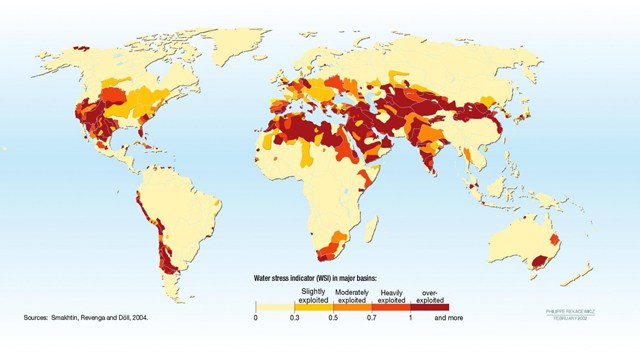
The presence of abundant natural resources, especially in poor, new, and underdeveloped states, is often perceived as a cause of or contributing factor to conflict. The disproportionate value of capturing or holding natural resources compared to other options incentivizes the use of illicit and violent means of achieving this.
Natural resource wealth as a driver of conflict is a major component of the Resource Curse. Also known as the paradox of plenty or the poverty paradox, the resource curse is the perceived phenomenon of countries with an abundance of natural resources (such as fossil fuels and certain minerals) having less economic growth, less democracy, or worse development outcomes than countries with fewer natural resources.[REF] There are many theories and much academic debate about the reasons for, and exceptions to, these adverse outcomes. Most experts believe the resource curse is not universal or inevitable, but affects certain types of countries or regions under certain conditions.[REF1][REF2]
A 2019 meta-analysis of 69 studies found "that there is no aggregate relationship between natural resources and conflict."[REF] According to a 2017 review study, "while some studies support the link between resource scarcity/abundance and armed conflict, others find no or only weak links."[REF] According to one academic study, a country that is otherwise typical but has primary commodity exports around 5% of GDP has a 6% risk of conflict, but when exports are 25% of GDP the chance of conflict rises to 33%.[REF] "Ethno-political groups are more likely to resort to rebellion rather than using nonviolent means or becoming terrorists when representing regions rich in oil."[REF]
There are several factors behind the relationship between natural resources and armed conflicts.[REF] Resource wealth may increase the vulnerability of countries to conflicts by undermining the quality of governance and economic performance[REF] (the "resource curse" argument). Secondly, conflicts can occur over the control and exploitation of resources and the allocation of their revenues (the "resource war" argument). Thirdly, access to resource revenues by belligerents can prolong conflicts (the "conflict resource" argument).[REF1][REF2] A 2018 study in the Journal of Conflict Resolution found that rebels were particularly likely to be able to prolong their participation in civil wars when they had access to natural resources that they could smuggle.[REF]
A 2004 literature review finds that oil makes the onset of war more likely and that lootable resources lengthen existing conflicts.[REF] One study finds the mere discovery (as opposed to just the exploitation) of petroleum resources increases the risk of conflict, as oil revenues have the potential to alter the balance of power between regimes and their opponents, rendering bargains in the present obsolete in the future.[REF] One study suggests that the rise in mineral prices over the period 1997–2010 contributed to up to 21 percent of the average country-level violence in Africa.[REF] Research shows that declining oil prices make oil-rich states less bellicose.[REF] Jeff Colgan observed that oil-rich states have a propensity to instigate international conflicts as well as to be the targets of them, which he referred to as "petro-aggression".[REF] Arguable examples include Iraq’s invasions of Iran and Kuwait; Libya’s repeated incursions into Chad in the 1970s and 1980s; Iran’s long-standing suspicion of Western powers;[REF] the United States' relations with Iraq and Iran. It is not clear whether the pattern of petro-aggression found in oil-rich countries also applies to other natural resources besides oil. A 2016 study finds that "oil production, oil reserves, oil dependence, and oil exports are associated with a higher risk of initiating conflict while countries enjoying large oil reserves are more frequently the target of military actions."[REF] As of 2016, the only six countries whose reported military expenditures exceeded 6 percent of GDP were significant oil producers: Oman, South Sudan, Saudi Arabia, Iraq, Libya, Algeria. (Data for Syria and North Korea were unavailable.)[REF] A 2017 study in the American Economic Review found that mining extraction contributed to conflicts in Africa at the local level over the period 1997-2010.[REF] A 2017 study in Security Studies found that while there is a statistical relationship between oil wealth and ethnic war, the use of qualitative methods reveals "that oil has rarely been a deep cause of ethnic war."[REF]
A 2016 study argues that petrostates may be emboldened to act more aggressively due to the inability of allied great powers to punish the petrostate.[REF] The great powers have strong incentives not to upset the relationship with its client petrostate ally for both strategic and economic reasons.[REF]
A 2017 study found evidence of the resource curse in the American frontier period of the Western United States in the 19th century (the Wild West).[REF] The study found that "In places where mineral discoveries occurred before formal institutions were established, there were more homicides per capita historically and the effect has persisted to this day. Today, the share of homicides and assaults explained by the historical circumstances of mineral discoveries is comparable to the effect of education or income."[REF]
A 2018 study in the Economic Journal found that "oil price shocks are seen to promote coups in onshore-intensive oil countries, while preventing them in offshore-intensive oil countries."[REF] The study argues that states which have onshore oil wealth tend to build up their military to protect the oil, whereas states do not do that for offshore oil wealth.[REF]



